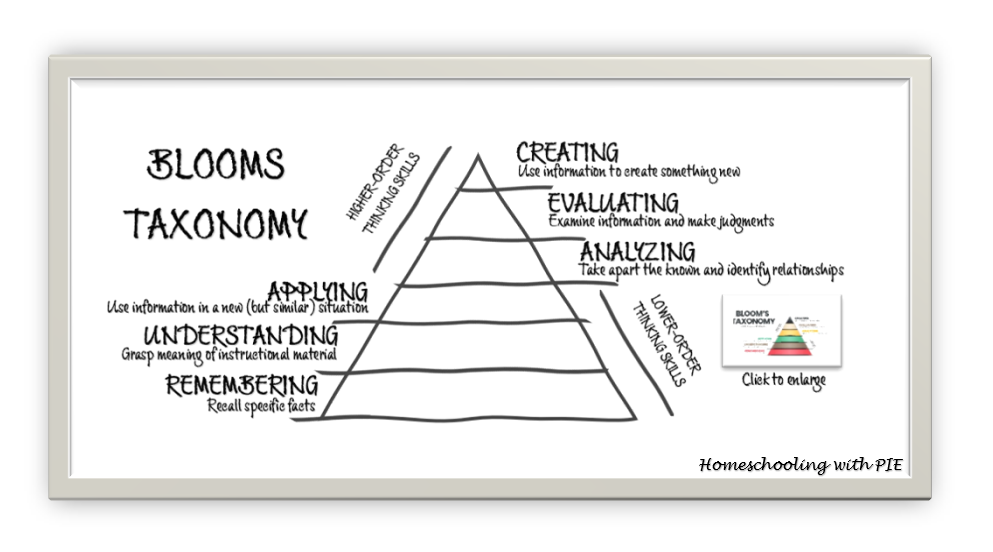MANAGING EXPECTATIONS: BLOOM'S TAXONOMY

Managing Expectations: Bloom's Taxonomy
Unlocking Learning: Understanding Bloom's Revised Taxonomy
Education is a dynamic process that goes beyond the rote memorization of facts. To foster true understanding and critical thinking, parents have the option of employing frameworks like Bloom's Revised Taxonomy. Originally introduced by Benjamin Bloom in the 1950s and refined over time, this taxonomy serves as a guide for classifying educational objectives and learning outcomes into a hierarchy of cognitive skills. Comprising six levels, each tier represents a distinct degree of cognitive complexity.
1. Remembering: Foundation of Knowledge
The first level of Bloom's Revised Taxonomy is Remembering. At this stage, learners recall or recognize information. This includes tasks such as memorizing facts, defining terms, and remembering details. Remembering lays the foundation for more advanced cognitive processes, ensuring students have a solid grasp of the basic elements within a subject.
- This level involves recalling information, facts, or basic concepts.
- Activities include memorization, recognizing, and recalling.
Impact on Competency: Establishes foundational knowledge.
Examples:
- Middle School: Memorizing historical dates or multiplication tables.
- High School: Recalling key scientific principles or historical events.
2. Understanding: Grasping the Meaning
Moving beyond mere recollection, Understanding involves comprehending and interpreting information. Learners at this level explain ideas or concepts, summarize information, and interpret data. This level promotes a deeper connection with the subject matter, requiring students to go beyond surface-level knowledge.
- Involves grasping the meaning of information, explaining concepts, and interpreting materials.
- Activities include summarizing, paraphrasing, and explaining ideas.
Impact on Competency: Enhances the ability to explain concepts.
Examples:
- Middle School: Explaining the main idea of a story or summarizing a scientific concept.
- High School: Interpreting literature or understanding the principles behind a chemical reaction.
3. Applying: Bridging Knowledge and Action
Applying takes learning to practical dimensions. This level requires the use of knowledge and understanding in new situations. Students apply concepts and principles to solve problems, use information in novel contexts, or carry out procedures. Applying knowledge reinforces the idea that learning is a dynamic process, not confined to the classroom.
- The focus is on using acquired knowledge in new situations or applying it in different contexts.
- Activities involve using information in a practical or real-world setting.
Impact on Competency: Develops practical skills and problem-solving abilities.
Examples:
- Middle School: Solving math problems involving real-world scenarios.
- High School: Applying historical knowledge to analyze current events or using mathematical formulas to solve scientific problems.
4. Analyzing: Breaking Down Information
The Analyzing level involves breaking down information into its components and understanding the relationships between these components. This tier includes tasks such as analyzing data, identifying patterns, and organizing information. Analytical skills are crucial for developing a deeper understanding of complex topics and preparing learners for more advanced cognitive challenges.
- Involves breaking down information into parts and understanding the relationships between them.
- Activities include comparing, contrasting, and organizing information.
Impact on Competency: Fosters critical thinking and the ability to analyze complex scenarios.
Examples:
- Middle School: Comparing and contrasting characters in a novel.
- High School: Analyzing the components of an experiment or dissecting the causes and effects of historical events.
5. Evaluating: Making Informed Judgments
Evaluating is the level at which learners make judgments about the value of information or methods. This involves critiquing, judging, and defending opinions based on evidence. Evaluative thinking encourages students to develop a discerning mindset, crucial for navigating a world filled with diverse information and perspectives.
- This level involves making judgments, assessing information, and defending opinions.
- Activities include critiquing, judging, and evaluating the validity of information.
Impact on Competency: Encourages independent thinking and the ability to evaluate the quality of information.
Examples:
- Middle School: Evaluating the credibility of sources for a research project.
- High School: Assessing the validity of scientific theories or critiquing an author's argument in a literary work.
6. Creating: Synthesizing Knowledge
At the pinnacle of Bloom's Taxonomy is Creating. This level involves putting elements together to form a coherent or functional whole. Students engage in tasks such as designing, composing, and producing original work. Creating challenges for learners to synthesize their knowledge, fostering creativity and innovation.
- The highest level of Bloom's Taxonomy, involves synthesizing information, creating new ideas, and generating original work.
- Activities include designing, constructing, and composing new material.
Impact on Competency: Cultivates creativity and the ability to innovate.
Examples:
- Middle School: Designing a project or creating a story based on a given theme.
- High School: Developing a hypothesis for a scientific experiment or crafting an original piece of art or literature.
IMPLEMENTING BLOOM'S TAXONOMY IN EDUCATION
As educators themselves, parents have the option of utilizing Bloom's Taxonomy as a roadmap to design effective learning experiences. The framework guides the development of learning objectives, assessments, and instructional activities that target different cognitive levels. By doing so, parents can ensure a balanced approach to teaching and learning, moving beyond the simple recall of facts to foster more complex and critical thinking skills.
In essence, Bloom's Revised Taxonomy is not just a tool for parents or educators; it's a key to unlocking the full potential of learners. By recognizing and addressing the different levels of cognitive skills, parents and educators pave the way for students to become critical thinkers, problem solvers, and lifelong learners. In a world where adaptability and creativity are prized, Bloom's Taxonomy remains a timeless and invaluable resource in the realm of education.
Managing Expectations: Bloom's Taxonomy